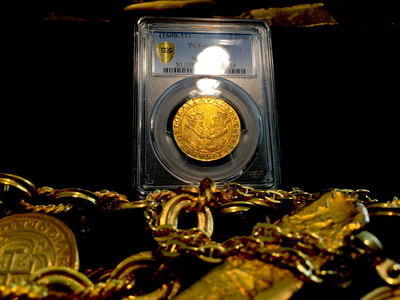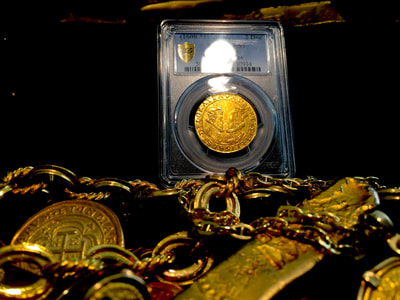Belgium 2 Ducat 1600-11 "King Albert & Isabella" PCGS 55
BELGIUM 2 DUCAT 1600-11 "ALBERT & ISABELLA" BRABANT PCGS 55 ANTWERP MINT, A SHARPLY STRUCK PIECE WITH INCREDIBLE ORIGINAL LUSTER!
Archduke Albert was the fifth son of Holy Roman Emperor Maximilian II and Maria of Spain, daughter of Holy Roman Emperor Charles V and Isabella of Portugal. He was sent to the Spanish Court at the age of eleven, where his uncle, King Philip II, looked after his education.
After the death of Archduke Ernst in 1595, Albert was sent to Brussels to succeed his elder brother as Governor General of the Habsburg Netherlands. He made his entry in Brussels on 11 February 1596. His first priority was restoring Spain's military position in the Low Countries. Spain was facing the combined forces of the Dutch Republic, England and France and had known nothing but defeats since 1590. During his first campaign season, Albert surprised his enemies by capturing Calais and nearby Ardres from the French and Hulst from the Dutch. These successes were however offset by the third bankruptcy of the Spanish crown later that year. The first half of the reign of Albert and Isabella was dominated by war. After overtures to the United Provinces and to Queen Elizabeth I of England proved unsuccessful, the Habsburg policy in the Low Countries aimed at regaining the military initiative and isolating the Dutch Republic. The strategy was to force its opponents to the conference table and negotiate from a position of strength. Even if Madrid and Brussels tended to agree on these options, Albert took a far more flexible stance than his brother-in-law, King Philip III of Spain. Albert had first hand knowledge of the devastation wrought by the Dutch Revolt and had come to the conclusion that it would be impossible to reconquer the northern provinces. Quite logically, Philip III and his councillors felt more concern for Spain's reputation and for the impact that a compromise with the Dutch Republic might have on Habsburg positions as a whole. Spain provided the means to continue the war. Albert took the decisions on the ground and tended to ignore Madrid's instructions. Under the circumstances, the division of responsibilities repeatedly led to tensions.
As the years passed, it became clear that Albert and Isabella Clara Eugenia would never have children. When Albert's health suffered a serious breakdown in the winter of 1613-1614, steps were taken to ensure the accession of Philip III of Spain in accordance to the Act of Cession. As a result, the States of the loyal provinces swore to accept the King as heir of the Archduke and Archduchess in a number of ceremonies between May 1616 and January 1617. Philip III however predeceased his uncle on 31 March 1621. The right to succeed the couple thereupon passed to his eldest, Philip IV.
Archduke Albert was the fifth son of Holy Roman Emperor Maximilian II and Maria of Spain, daughter of Holy Roman Emperor Charles V and Isabella of Portugal. He was sent to the Spanish Court at the age of eleven, where his uncle, King Philip II, looked after his education.
After the death of Archduke Ernst in 1595, Albert was sent to Brussels to succeed his elder brother as Governor General of the Habsburg Netherlands. He made his entry in Brussels on 11 February 1596. His first priority was restoring Spain's military position in the Low Countries. Spain was facing the combined forces of the Dutch Republic, England and France and had known nothing but defeats since 1590. During his first campaign season, Albert surprised his enemies by capturing Calais and nearby Ardres from the French and Hulst from the Dutch. These successes were however offset by the third bankruptcy of the Spanish crown later that year. The first half of the reign of Albert and Isabella was dominated by war. After overtures to the United Provinces and to Queen Elizabeth I of England proved unsuccessful, the Habsburg policy in the Low Countries aimed at regaining the military initiative and isolating the Dutch Republic. The strategy was to force its opponents to the conference table and negotiate from a position of strength. Even if Madrid and Brussels tended to agree on these options, Albert took a far more flexible stance than his brother-in-law, King Philip III of Spain. Albert had first hand knowledge of the devastation wrought by the Dutch Revolt and had come to the conclusion that it would be impossible to reconquer the northern provinces. Quite logically, Philip III and his councillors felt more concern for Spain's reputation and for the impact that a compromise with the Dutch Republic might have on Habsburg positions as a whole. Spain provided the means to continue the war. Albert took the decisions on the ground and tended to ignore Madrid's instructions. Under the circumstances, the division of responsibilities repeatedly led to tensions.
As the years passed, it became clear that Albert and Isabella Clara Eugenia would never have children. When Albert's health suffered a serious breakdown in the winter of 1613-1614, steps were taken to ensure the accession of Philip III of Spain in accordance to the Act of Cession. As a result, the States of the loyal provinces swore to accept the King as heir of the Archduke and Archduchess in a number of ceremonies between May 1616 and January 1617. Philip III however predeceased his uncle on 31 March 1621. The right to succeed the couple thereupon passed to his eldest, Philip IV.















